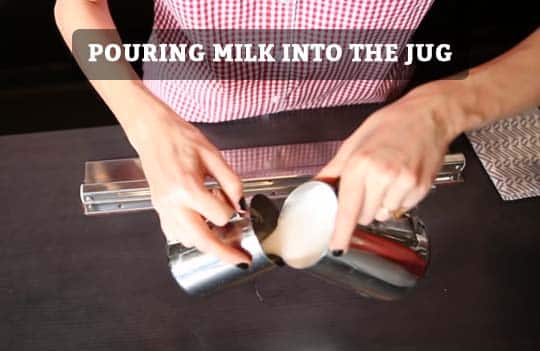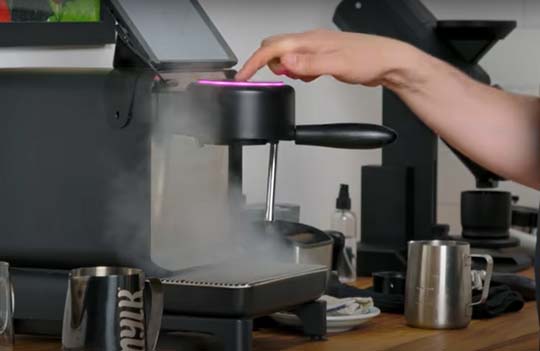There is a reason why milk and coffee complement each other so well. Milk offers a layer of flavor complexity that balances out the natural flavors of coffee. Milk creates a profound and complex flavor profile in coffee, highlighting natural floral, caramel, and roasted notes.
Steaming or foaming milk produces a sweet, creamy texture that heating milk alone cannot. In addition, there’s something special about the bubbles on top of your coffee drinks. You must also know the technicalities of steaming or frothing milk for your milk-based coffees.
To make a barista-style milk-based coffee at home, you must own a Nespresso machine and know how to steam milk. We have some tips and tricks for doing it the easiest way without wasting time or milk. Don’t give up if it’s not up to the mark the first time; you’ll get better at it with practice.
What is the difference between frothing and steaming?
Before jumping into the steaming process, we need to clarify if you know the difference between steamed and frothed milk. There is a general misconception that steamed and frothed milk are the same and that it’s just two different terms for them. That’s not true!
Steaming milk involves heating it to the appropriate temperature, usually by immersing a steam wand in a pitcher. No whipping is involved in steaming milk, so it is smooth and creamy.

In contrast, frothed milk uses air to whip it up. To do this, place the steam wand’s tip on the milk’s surface. The purpose of foamed milk is to create microfoam, lighter and less dense than steamed milk.
How to Froth Milk like a Barista?
Not every coffee beverage requires frothed milk, but it instantly adds texture and taste. We have a few steps for you to froth milk at home like a barista.
Note: We recommend fresh and cold milk for frothing.
What you will need:
- An espresso machine with a steam wand
- Milk
- Milk Jug
- Thermometer (optional)
Method:
1. Pour the milk into the jug
Pour the milk into the jug, keeping in mind that you can not fill it to the top. It must be halfway through the jug or less because frothing expands the milk and doubles its volume, so we need extra space in the jug.

2. Turn on and off the steam wand to purge it
Before starting the frothing process, you need to purge your steam wand. This step is important for hygiene but also the quality of frothed milk. The milk or coffee from its previous use can dry up and clog the wand. So, turn it on for five seconds and off, removing any standing residue or water.
3. Place the tip of the steam wand in the milk
In this step, place the tip of the steam wand into the milk. It should be below the surface of the milk. Once you place it in its position, turn it on at full power.

4. Turn on the steam wand
Turn it on with full power to start the frothing of the milk. The trick here is to understand the sound of the frothing milk. If it’s a chirping sound, keep the steam wand intact and continue the process.

5. Adjust the steam wand
Once the frothing begins, you might have to adjust the steam wand. The wand is too close to the jug’s surface if the sound is too low. If you hear a splattering sound, the wand is too high in the jug, and you need to lower it.
6. Check Temperature
This step is essential to get perfectly frothed milk. When the thermometer reads 40 to 40°C, angle the jug so that the wand is lower than the milk’s surface and near the sides of the jug.
Switch the steam wand off when the temperature reaches 60 to 70°C because your frothed milk is ready.
7. Frothed milk is ready
Now that your frothed milk is ready, tap the jug slightly to even out any air bubbles. After every use, clean the steam wand with a damp cloth.

What Kind of Milk is Best for Steaming?
It’s also critical to use the right milk when steaming. The details are endless! Here’s what you need to know:
1. Use Fresh Milk
Fresh milk gives the best texture and taste to steamed milk. Try to use as much fresh milk as possible.
2. Use Whole Milk
Whole milk is ideal for steaming milk because it has a high fat content. If not high, you can use milk with 2% fat content, but it would not give you a rich enough texture.
3. Use Non-Dairy Milk
If you are allergic to dairy or don’t like it, use oat milk or coconut milk as a non-dairy alternative. It has great flavor and works well for frothing.
What Mistakes to Avoid while frothing milk?
Frothing milk is no rocket science, but if you try it hands-on for the first time, you might make some mistakes. Some of the common milk-frothing mistakes are as follows:
1. Don’t overheat the milk
The baristas can tell the temperature without using any device. You can use a thermometer to ensure you don’t overheat the milk. Overheating milk affects its flavor and its texture.
2. Don’t Aerate milk for too long
You get the best texture of milk when you froth it cold. If you aerate milk for too long and it becomes warm, it will become watery and lose its texture.
3. You are not creating a Whirlpool
To achieve that creamy texture, you must find the sweet spot that creates a whirlpool.
4. Don’t wait too long after steaming
Once you have steamed milk, keep stirring the pitcher till you pour it into your drink. If you keep it aside for a few minutes, the foam will separate from the milk and have a lighter consistency.
How do you Steam Milk without a Steam Wand?
Don’t you have an espresso machine with a steam wand? No worries, we have got your back. You can also steam milk to make your favorite milk-based beverage in other ways. We have come up with ideas to utilize household items for steaming milk. Following are the ways to steam milk without a steam wand:
1. Use a Microwave to Steam Milk
It is a simple and easy way of steaming milk if you don’t have a steam wand, and we will tell you how to do it. Take a microwave-safe container and fill it with the desired amount of milk. Ensure you leave adequate space in the cup and fill ½ or ¾ of it with milk.

Set the timer to 20 to 45 seconds according to the amount of milk in the cup. Once the time is up, insert the thermometer to check if it reads 65C, you have hit the spot. Add it to your coffee without any wait!
Tip: If the temperature is lower, heat it for a few more seconds. If it is higher, remember to heat it less the next time.
2. Steam Milk on a Stove Top
Using a stovetop is probably one of the easiest ways of steaming milk because everyone has a stove at home that gives you control over the heat and adjusts it accordingly.

Add milk to a pot and put it on low to medium heat. The milk you use depends on your preference but start with a small amount. Keep stirring the milk, so it doesn’t dry up to the sides of the pot. Once the temperature reaches 65°C, take it off the heat and add it directly to your brewed coffee.
Tip: if you are new at this method and your milk dries up too quickly, use a double boiler.
3. Use a French Press for Steaming Milk
Using a french press to steam milk is a viable option if you have company over and need to make more than one cup of coffee.
Preheat your milk on the stovetop before adding it to the french press. Once you add milk to the carafe of the french press, vigorously pump the plunger through the milk until it reaches the desired consistency. You will need practice to figure out the perfect speed at which you pump the milk to create a creamy texture.
4. Use a Whisk to prepare Steamed Milk
You can also use a handheld whisk to add texture to steamed milk. For this purpose, heat the milk on the stovetop on low heat. While it heats up, whisk it to achieve the desired texture. The milk will have a light foam when it reaches the right temperature.
5. Use an Automatic Frother for Steamed Milk
Warm the milk and transfer it to a heatproof, stainless steel milk pitcher or jug. Tilt the pitcher slightly to pull in some air, and then use the frother to whip the milk. Once the milk reaches the desired consistency, lower the frother to create a vortex.
Final Thoughts
It doesn’t matter how you steam milk. You can use an espresso machine with a steam wand or a whisk to achieve the desired consistency. All you need to know is that practice will make your steamed milk smooth.
We hope this article will help you to get those bubbles right. Get the perfect froth!
FAQs
How do you steam milk for a latte at home?
In a mason jar, shake nonfat or full-fat milk until it’s foamy, and remove the lid. Put milk in the microwave for a few seconds. You will get creamy milk for your latte art and spoonfuls of foam.
Does steaming milk make it sweeter?
Yes, steaming milk makes it sweeter. It caramelizes lightly and adds sweetness as the heat breaks the lactose (milk sugar).
What is the difference between whole milk and skim milk?
Cow’s milk that retains its original fat content (about 3.5%) is known as whole milk. On the other hand, skim milk has the same amount of protein as whole milk but has a lower fat content (about 0.1 to 0.3%) and fewer calories.
Can You froth cold milk?
Of Course, you can! Frothing cold milk is ideal for making cold foam for iced drinks like an iced latte. You can froth cold milk using an automatic frother, an electric frother, or a blender.
How hot should steaming milk be?
A temperature of 55 to 62 degrees Celsius is ideal for steaming milk.

